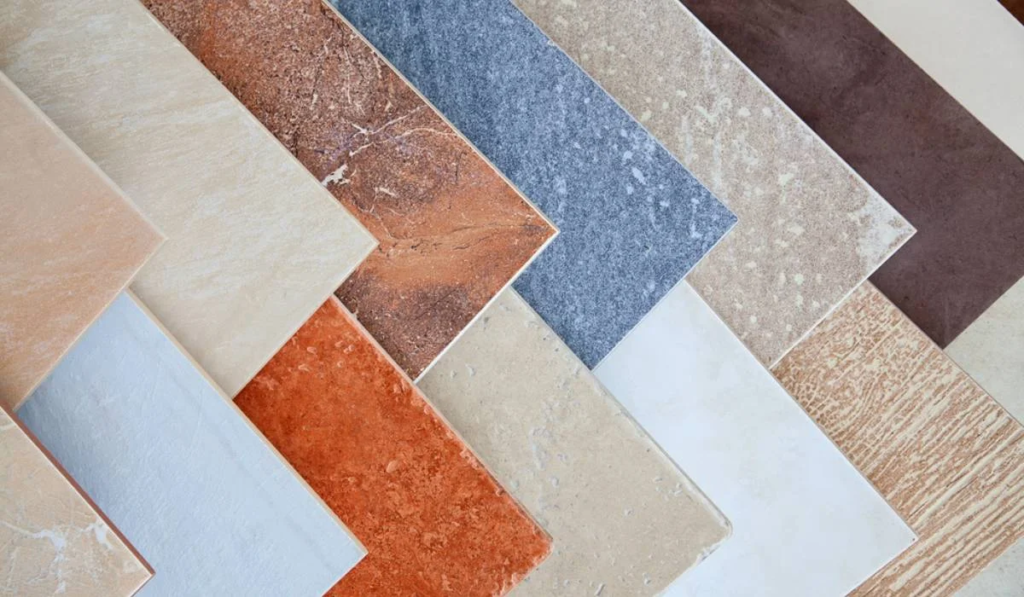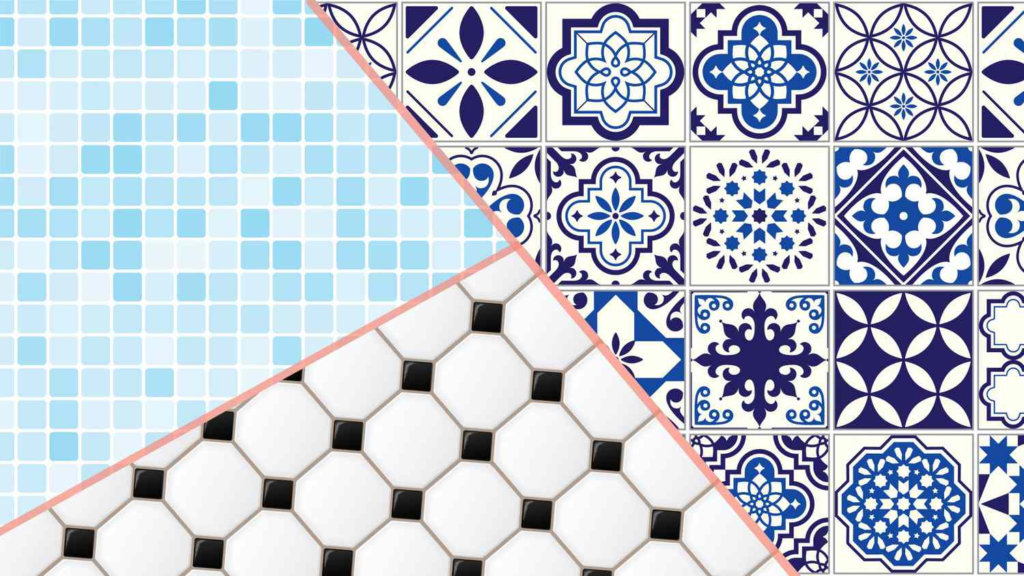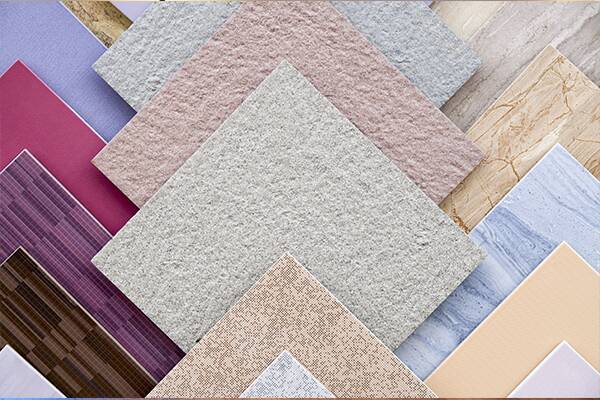Making the appropriate tile selection for your living room is an important interior design choice. Tiles affect your space’s functionality and maintenance in addition to its appearance. It can be difficult to choose wisely when there are so many options on the market. We’ve examined over 10 important factors to take into account when choosing tiles for your living room to assist you in making this choice successfully.
Selecting tiles for your living room is an important decision that can greatly impact the overall aesthetics and functionality of the space. Here are more than 10 factors to consider when choosing tiles for your living room:
Budget: Determine your budget for the project. Tiles come in a wide range of prices, so knowing your budget will help narrow down your options.
Floor or Wall: Decide whether you want tiles for the floor, wall, or both. Different types of tiles are suitable for different applications.
Style and Design: Consider the overall style and design of your living room. Do you want a modern, traditional, or eclectic look? Choose tiles that complement your desired aesthetic.
Color: Choose a color scheme that matches or complements the existing colors in your living room. Lighter colors can make a space look larger, while darker colors add warmth.
Size and Shape: Tile size and shape can greatly impact the appearance of your living room. Large tiles can create a sense of openness, while smaller tiles can add texture and detail.
Material: Tiles come in various materials, including ceramic, porcelain, natural stone (such as marble or slate), and more. Each material has its own characteristics, so consider factors like durability, maintenance, and appearance.
Texture: Decide whether you want smooth, glossy tiles or textured ones. Textured tiles can add depth and visual interest to your living room.
Durability: Consider the durability of the tiles, especially if your living room is a high-traffic area. Porcelain tiles are known for their durability and resistance to wear and tear.
Maintenance: Some tiles require more maintenance than others. For example, natural stone tiles may need regular sealing. Choose tiles that align with your willingness to maintain them.
Pattern: Explore different tile patterns like herringbone, basketweave, or subway tiles to add visual interest to your living room. The choice of pattern can significantly impact the overall look.
Ease of Installation: If you’re planning to DIY the installation, select tiles that are easier to work with. Some tiles, like large-format ones, can be more challenging to install.
Grout Color: The color of the grout can affect the overall appearance of the tiled surface. Consider whether you want a contrasting or matching grout color.
Environmental Impact: If environmental sustainability is important to you, look for eco-friendly tile options made from recycled materials or those with low VOC emissions.
Lighting: Take into account the lighting conditions in your living room. Light can affect the perception of color and texture, so consider how the tiles will look in different lighting situations.
Sample Tiles: Always obtain sample tiles before making a final decision. Test them in your living room to see how they look in your specific space and lighting.
Professional Advice: If you’re unsure about your choices, consult with a tile professional or an interior designer who can provide expert guidance based on your preferences and needs.
Long-Term Considerations: Think about how your tile choice will age over time. Will it still look good in your living room several years down the line?
Which colors should I choose, and why?
When it comes to designing your living room, one of the most critical decisions is choosing the right tiles. Tiles not only influence the overall aesthetics of the space but also contribute to its functionality and ambiance. Among the numerous factors to consider, color is undeniably a pivotal element.
Consider the Following Color Options and Their Implications:
1. Neutrals: Timeless Elegance
- Neutral colors like white, gray, beige, and taupe are timeless and versatile. They create a clean, serene backdrop that suits various design styles, from contemporary to traditional.
- Neutrals make a room appear more spacious and allow you to experiment with other colors through furniture, decor, and accessories. They also promote a sense of calm and relaxation.
2. Earth Tones: Natural Warmth
- Earthy colors such as brown, terracotta, and deep greens bring the warmth of nature indoors. They create a cozy and inviting atmosphere, perfect for relaxation.
- Earth tones can add depth and a sense of connection to the outdoors. They work exceptionally well in rustic, bohemian, or Scandinavian design themes.
3. Bold and Vibrant: Expressive Flair
- Bold colors like deep blues, rich reds, and vibrant greens can inject energy and personality into your living room. They are ideal for those who want to make a statement.
- These colors can be used as accents or focal points, creating a striking contrast and visual interest. They can also inspire creativity and conversation.
4. Monochromatic: Sleek, and Modern:
- Monochromatic color schemes involve various shades of a single color, such as different grays or blues. This approach creates a sophisticated and harmonious look.
- Monochromatic designs provide a cohesive and calming atmosphere. They are particularly suitable for minimalist or contemporary interiors.
5. Pastels: soft and tranquil
- Soft pastel hues like light blues, pinks, and greens exude a sense of serenity and simplicity. They are perfect for creating a soothing living space.
- Pastel colors can make your living room feel light and airy. They are great for promoting relaxation and reducing stress.
6. Patterned and Mosaic: Expressive Creativity
- Patterns and mosaics allow you to combine various colors and create unique designs. They can be bold and eclectic or subtle and intricate.
- Patterned tiles add visual interest and can be a focal point in your living room. They enable you to infuse your personal style into the space.
Which size to choose?
When choosing tiles for your living room, keep in mind that the size of the tiles can have a big impact on the room’s overall appearance and atmosphere. You should consider the size of your living room, your aesthetic preferences, and the desired design effect when selecting the size of the tiles. Here are some typical tile sizes in meters (as well as an approximation of their size in inches) and factors to take into account for each:
- Small Tiles (less than 0.3 square meters or 3 square feet per tile):
- Examples: 10×10 cm (4×4 inches), 15×15 cm (6×6 inches)
- Use: Small tiles are often used for intricate mosaic patterns, backsplashes, or decorative accents. They can add texture and detail to your living room.
- Medium Tiles (0.3 to 0.6 square meters or 3 to 6 square feet per tile):
- Examples: 30×30 cm (12×12 inches), 45×45 cm (18×18 inches)
- Use: Medium-sized tiles are versatile and can be used for both floors and walls. They offer a balance between aesthetics and ease of installation.
- Large Format Tiles (over 0.6 square meters or 6 square feet per tile):
- Examples: 60×60 cm (24×24 inches), 90×90 cm (36×36 inches)
- Use: Large format tiles create a modern and spacious look with fewer grout lines. They are often used for large floor areas and can make a room appear larger.
- Rectangular Tiles:
- Examples: 20×40 cm (8×16 inches), 30×60 cm (12×24 inches)
- Use: Rectangular tiles can be laid in different patterns, such as a brick or herringbone pattern, to add visual interest. They are suitable for both floors and walls.
- Plank Tiles (Rectangular and Long):
- Examples: 20×120 cm (8×48 inches), 30×150 cm (12×60 inches)
- Use: Plank tiles mimic the look of hardwood flooring and are often used to create a contemporary or rustic aesthetic in living rooms.
- Hexagonal Tiles:
- Example: 20 cm (8 inches) hexagons
- Use: Hexagonal tiles offer a unique and visually striking option for floors and walls. They can create interesting patterns and focal points.
Which material to use?
When it comes to selecting the perfect tiles for your living room, one of the most critical decisions you’ll face is choosing the right material. Each tile material has its own set of pros and cons that can significantly impact the look, feel, and functionality of your space. Here’s a closer look at some common tile materials to help you make an informed choice:
1. Ceramic Tiles:

For living rooms, ceramic tiles are a time-honored and flexible option. Finding the ideal match for your design theme is simple thanks to their wide variety of colors, sizes, and patterns.
Pros: Variety, Durability, and Ease of Maintenance.
Cons: Not suitable for outdoor use; chippable.
2. Porcelain Tiles:

Ceramic tiles are a subset of porcelain tiles, which are less porous and denser. Porcelain tiles are a great option for homes with children, pets, and active living rooms due to their inherent durability.
Pros: Durability, low maintenance, versatility, and excellent radiant heating.
Cons: Cost and hardness.
3. Natural Stone Tiles:

Tiles such as marble, travertine, and slate, are the best option for anyone looking to furnish an opulent and elegant living room. Natural stones come in a variety of colors and veining patterns, giving each one a distinctive appearance.
Pros: Variety, Durability, and Aesthetic Appeal.
Cost: Cost, Maintenance, Weight.
4. Glass Tiles:

Your living room gets a contemporary elegance and sophistication boost from glass tiles. They come in a range of hues and textures, such as glossy and frosted. Glass tiles are frequently used in mosaic designs or as accent pieces to make striking focal points.
Pros: Versatility, Ease of Cleaning, and Exceptional Aesthetics.
Cons: Expensive, flimsy, and slippery when wet.
Ultimately, the choice of tile material for your living room will depend on your budget, design preferences, and the specific demands of your space. Each material has its own unique characteristics, and by weighing the pros and cons, you can make an informed decision that suits both your aesthetic and practical needs.
What pricing range is available?
It is important to take into account your budget as well as the advantages and disadvantages of various price ranges because the market in India offers a wide variety of tile options at various price points.
1. Budget-Friendly Tiles (₹25 – ₹60 per square foot):
- Pros:
- Affordable and suitable for cost-conscious buyers.
- A wide variety of designs and colors are available.
- Good for temporary or rental properties.
- Cons:
- May lack the durability and premium finish of higher-priced tiles.
- Limited choices in terms of size and material.
2. Mid-Range Tiles (₹60 – ₹150 per square foot):
- Pros:
- Offers a balance between quality and affordability.
- A wide range of designs, sizes, and materials are available.
- Suitable for most residential applications.
- Cons:
- Some premium designs and materials may still be out of reach.
3. Premium Tiles (₹150 – ₹500+ per square foot):
- Pros:
- Exceptional quality, durability, and aesthetics.
- Wide selection of luxurious designs, materials, and finishes.
- Ideal for high-end residential and commercial spaces.
- Cons:
- Can be significantly more expensive.
- May require professional installation, adding to the cost.
What are the current trends?
A professional interior designer or more recent sources are recommended for the most recent trends because design trends can change over time.
- Large Format Tiles: Large-format tiles, often measuring 24×24 inches or more, were gaining popularity. They create a sleek and modern look with fewer grout lines.
- Wood-Look Tiles: Tiles that mimic the look of wood flooring continued to be in demand. They offer the appearance of wood with the durability and easy maintenance of tiles.
- Terrazzo Tiles: Terrazzo, with its unique and colorful speckled patterns, made a comeback as a trendy tile choice for both floors and walls.
- Subway Tiles with a Twist: While subway tiles have been a classic choice, they saw updates with variations in size, color, and layout patterns. Colored and textured subway tiles were particularly popular.
- Geometric Patterns: Geometric tiles in various shapes, such as hexagons, diamonds, and chevrons, added visual interest to spaces. These could be used to create intricate patterns or as accent pieces.
- Monochromatic and Neutral Colors: Minimalism continued to influence tile choices, with monochromatic and neutral color schemes like whites, grays, and beiges dominating.
- Matte Finishes: Matte-finished tiles, which offer a soft and understated look, were preferred over glossy tiles in many interior designs.
- Patterned Cement Tiles: Encaustic or cement tiles with intricate and colorful patterns were used to create eye-catching focal points, often in kitchens and bathrooms.
- Metallic and Textured Tiles: Metallic accents and textured tiles, such as those with 3D designs or metallic finishes, added depth and luxury to spaces.
- Natural Stone Tiles: Natural stone tiles like marble, travertine, and slate were popular for their timeless elegance and unique veining patterns.
- Bold Colors: In some designs, bold and vibrant tile colors were used as statement pieces to create a dramatic effect in various living spaces.
- Mixed Materials: Combining different materials like glass, metal, and stone in mosaic patterns or mixed material tiles added interest and texture.
- Sustainability: Eco-friendly tiles made from recycled or sustainable materials were gaining traction as environmental concerns became more prominent.
- Textured Tiles: Tiles with textured surfaces, like 3D or raised patterns, added tactile and visual interest to walls and floors.
- Smart Tiles: Some companies started developing “smart” tiles with integrated technology, such as heating elements or LED lighting.
Conclusion:
Selecting tiles for your living room involves a combination of practicality and aesthetics. Take your time to explore various options, and don’t be afraid to seek advice from interior designers or experts if needed. By carefully considering factors like budget, material, size, color, and more, you can make an informed decision that transforms your living room into a space you’ll love for years to come. Remember, the right tiles can truly be the foundation of a beautiful living room. Hope you find this article useful. You can also check out other creative articles about home decor here. Happy exploring!

